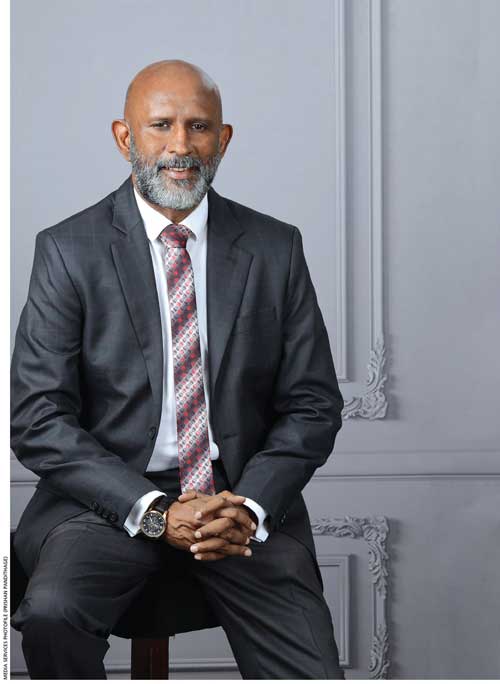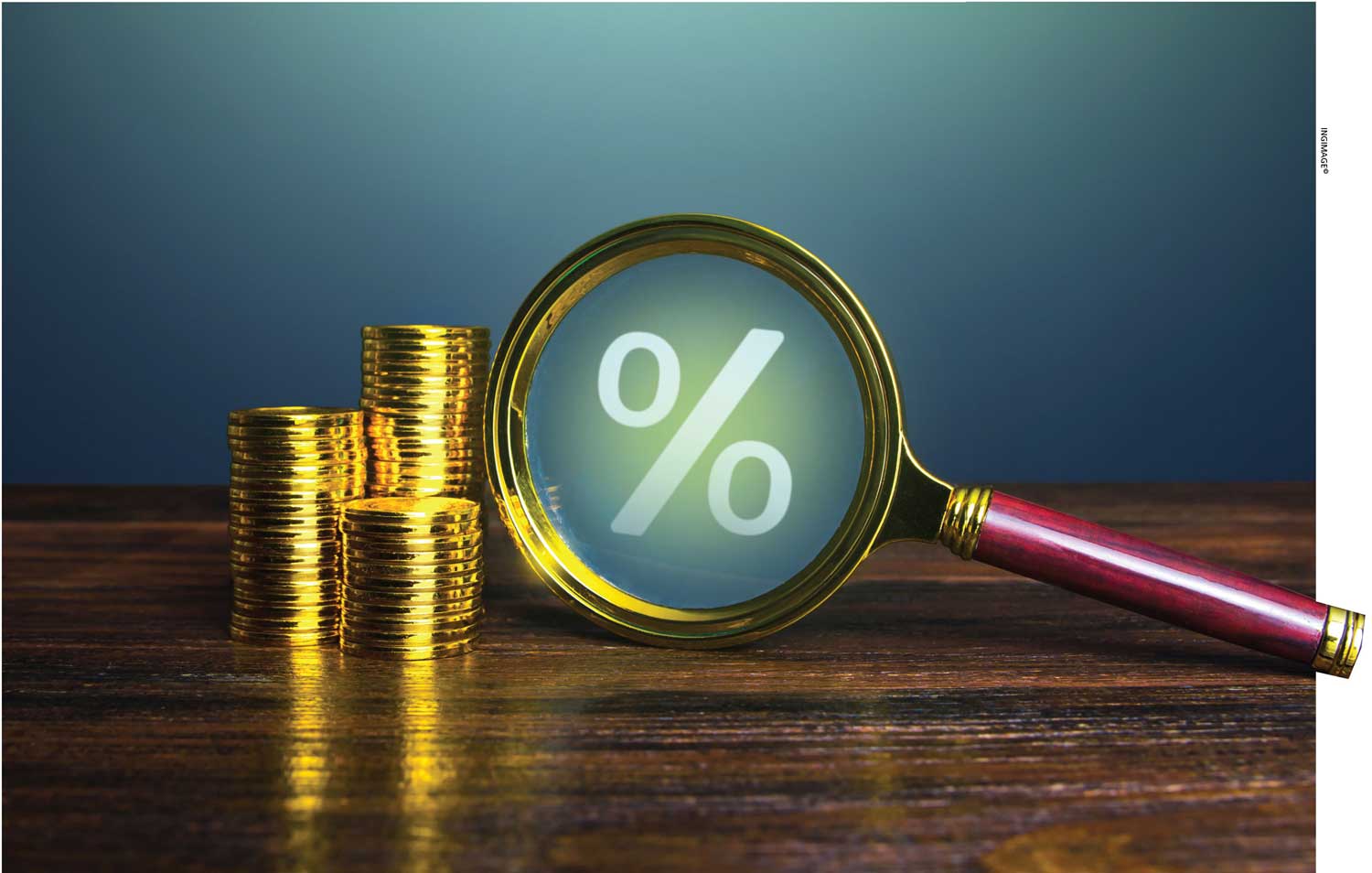
ECONOMIC REVIVAL
Compiled by Yamini Sequeira
RIDERS OF THE ECONOMIC STORM
 Naleen Edirisinghe credits the banking sector’s resilience for its turnaround
Naleen Edirisinghe credits the banking sector’s resilience for its turnaround
The banking sector has faced extensive challenges due to the twin shocks caused by the COVID-19 pandemic in 2020 and economic crisis last year. This resulted in a surge in interest rates and taxes as economic growth came to a grinding halt.
SECTOR RECOVERY However, Naleen Edirisinghe notes that “the banking sector is showing signs of recovery.”
He elaborates: “Foreign currency conditions are gradually improving and inflation is cooling faster than anticipated. The sector also seems to be moving past the spectre of domestic debt restructuring, which was one of the major overhangs until recently.”
“The chief catalyst for shaping a turnaround in the banking sector is the shifting of the interest rate cycle from ultra-tightening to one of the fastest and most aggressive easing cycles in monetary policy,” Edirisinghe asserts.
Having reduced its key lending rates by a cumulative 450 basis points in quick succession in June and July, the Central Bank of Sri Lanka signalled that it would keep the window open for more cuts. This step was taken to accelerate the monetary policy transmission process and drive lending rates down to accelerate the pace of credit flows into the economy.
POSITIVE GROWTH Edirisinghe predicts: “This move will catalyse the next leg of growth for banks, following one of the most painful periods in the history of the sector. A positive turnaround in sentiment in business and consumer circles will provide an additional boost as they restart spending after a long hiatus.”
Banks are poised to benefit from these developments as they’re cautiously reopening their lending taps as credit becomes affordable again for both businesses and individuals. This will enable the sector to reverse the contraction in banks’ loan books.
“We saw the initial signs emerging from the extremely positive growth in credit to the private sector by licenced commercial banks in June,” he recalls.
Meanwhile, banks were also able to overcome the disruption of their physical activities through the use of digital platforms, which enabled them to provide seamless connectivity and banking services to clients.
Edirisinghe explains: “But the most painful situation was the prolonged shortage of foreign exchange last year, which brought the economy to a grinding halt – and sent inflation, interest rates and taxes through the roof. This sent ripples throughout consumer and credit markets. It also reversed growth and pushed borrowers into default.”
 CONTINUING RISK “There is a need to ‘de-risk’ the economy and business climate, and restore predictability by reducing uncertainty. I understand that this is happening – so banks can start lending again to help support the economic recovery,” he avers, commenting on the immediate risks facing the sector.
CONTINUING RISK “There is a need to ‘de-risk’ the economy and business climate, and restore predictability by reducing uncertainty. I understand that this is happening – so banks can start lending again to help support the economic recovery,” he avers, commenting on the immediate risks facing the sector.
Edirisinghe is confident that “as the rates are descending, this will offer a healthy mix for the banking sector to look past the period of pain and challenges – to one of growth and quality in banks’ assets once again.”
He believes that one way to stem the tide of the brain drain is to retain quality staff through career progression, engagements, rewards, and proper training and mentoring.
CREDIT FLOW Sharing his thoughts on maintaining liquidity in the market, Edirisinghe posits: “The quick fix is to ease rates in line with cooling inflation, which is happening even now. This will accelerate credit flows into the real economy, which in turn will resuscitate consumption and business spending once again – and rescue it from the depths it hit last year.”
“Inflation returning to the Central Bank’s desired range of mid-single digits so quickly is a welcome signal to rebuild consumer and business confidence in the context of the economy. But in the medium to long term, the economy will have to grow at a faster but sustainable pace to put more money in peoples’ pockets while controlling inflation,” he states.
FUTURE FOCUS Commenting on what the focus of commercial banks should be in the months ahead, Edirisinghe says: “SMEs were the most affected by the pandemic and economic crisis. However, commercial banks will support genuinely affected small and medium-size enterprises to overcome the crisis.”
He adds: “Our efforts along these lines are gradually reaping benefits with many of them improving their business prospects at a rapid pace.”
“On the other hand, we have also seen a set of wilful defaulters emerging – they became comfortable making use of the moratoriums issued since the April 2019 Easter Sunday bombings. Banks will make every effort to recover those facilities as quickly as they can,” he assures.
Edirisinghe continues: “As a country, we have learnt many bitter lessons in the past three years. And moving forward, we should focus on areas such as exports, tourism, renewable energy, IT and education to resurrect our ailing economy.”
ESG PRINCIPLES “Sri Lanka is making steady progress in the area of environmental, social and corporate governance (ESG) principles. It is lagging behind developed nations however, especially given the current climate-related challenges such as extreme heat and other catastrophes, which are taking place here and around the world,” he says, regarding the contribution made by banks to sustainability.
Edirisinghe believes that the banking sector should support the global climate agenda and sustainability goals set by the UN, affirming that “many banks have already developed their own sustainability policies and strategies, and embedded these into their credit decisions.”

THE OUTLOOK Looking ahead, he says: “I believe that 2023 is going to be the year for turning around as the banking sector is already moving towards growth, having contracted and earned low profits in recent times.”
He believes that “the easing of rates will accelerate growth, and bode well for the banking sector in general and financial services industry as a whole – and lay a solid platform in the medium term for Sri Lanka’s economy to strengthen.”
“Banks are slowly entering the capital market for raising debt capital and this will accelerate when conditions become favourable. This means that banks are poised for growth, and strengthening their capital and liquidity profiles to meet this demand, which could arise in pent-up fashion following more than a year of negative growth,” Edirisinghe concludes.






